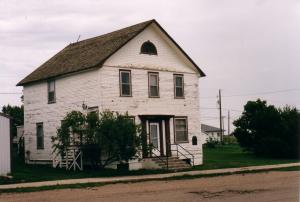
Village, pop 75 (2006c), 57 (2001c), is located southeast of Outlook on Hwy 19. Settlers began arriving in the area about 1904: they were mainly people from eastern Canada (Ontario, Quebec, and New Brunswick); English and Scottish arrivals from Great Britain; and people of Norwegian origin from the central United States. With the construction of the CPR rail line from Moose Jaw to Outlook, the village of Hawarden had its beginnings; the track was built through the Hawarden area in 1908, and by 1909 the length of the line was completed. That year, the Hawarden Post Office was established, the school district centred on the village was set up, the Canadian Bank of Commerce opened a branch, and on July 16 the community was incorporated. It was named after Hawarden Castle in Flintshire, Wales, the stately country residence of William Ewart Gladstone (1809-98), Queen Victoria’s four-time prime minister. The main street of Hawarden, Saskatchewan is named Gladstone; the two either side are named William and Ewart. Other streets are named Chester, after an English city just across the border from Flintshire; and Dee, after a prominent river that forms part of the border between Wales and England, and which runs through Chester. By 1911, Hawarden, Saskatchewan, was fairly well established – the population was at 126 – but two weeks before Christmas that year, fire wiped out a half of a dozen businesses. Still the community grew: a local light plant was providing some electricity by 1915; by 1926 the village numbered 262 residents and it looked as though it would reach 300. It is interesting to note that Edward L. Diefenbaker, youngest paternal uncle of Prime Minister John Diefenbaker, was the principal at Hawarden School in 1922-23. The 1930s were devastating years for the community as the population plunged by almost 100 over the decade. The village rebounded somewhat during the post-war period, and for several years through the early to mid-1960s, while the dam building and other work on the South Saskatchewan River Project was underway, Hawarden’s population mushroomed as workers and their families thronged to the area. Afterwards, however, there began a steady decline: from 267 residents in 1966, the village was down to 133 a decade later. By the end of the 1970s the school was down to being a K-9 facility: students in grades 10-12 were being bussed 33 km northeast to kenaston. By the early 1990s, only grades K-6 were taught at Hawarden School, and in 1993 the school was closed. Most area students today attend school in Kenaston; some, though, travel south to the village of Loreburn. As though the loss of population and business, and the down-sizing of the school were not enough to endure, a tornado ripped through the village on July 5, 1988 – it uprooted trees, knocked boxcars off the railway tracks, and it caused extensive property damage throughout the village and area. With the demolition of the Pioneer grain elevator and its annexes in 1996, all that was left where six elevators once stood was the Pool elevator. But it only had a few years left and is gone now too. District farmers now haul their grain to the Gardiner Dam Terminal (south between the villages of Strongfield and Loreburn); it is a 17,000-tonne high throughput grain elevator jointly-owned by area producers and Agricore United. Businesses remaining in Hawarden today, scattered amongst a number of abandoned buildings and vacant lots, include Perry Industries, a manufacturing company that produces products for the agriculture and construction industries; a trucking company that hauls grain; the Hawarden Hotel and coffee shop; and the post office. There are a small number of tradespeople with home-based businesses. The last place to buy groceries and other essentials closed in the early 1990s. Hawarden has a community hall (which was a Presbyterian church until 1927), a Mason’s lodge (situated in a 1907 country schoolhouse), and a skating rink (in poor condition, but still flooded each winter). A few km west of Hawarden a family runs a bed and breakfast in their 1913 farmhouse. The last regular services were held in Christ Anglican Mission Church in Hawarden in 1979, and the 1926 building was designated a heritage property in 1985. Hawarden United Church began to rely on members of the lay ministry in 1997, and it closed its doors a few years later. Bethlehem Lutheran Church, approximately 11 km north of Hawarden, remains active: the congregation was organized in 1909, and the extant church building was erected in 1914. Hawarden is situated in the RM of Loreburn No. 254.
David McLennan
Print EntryHOME | BROWSE BY SUBJECT | ENTRY LIST (A-Z) | IMAGE INDEX | CONTRIBUTOR INDEX | ABOUT THE ENCYCLOPEDIA | SPONSORS TERMS OF USE | COPYRIGHT © 2006 CANADIAN PLAINS RESEARCH CENTER, UNIVERSITY OF REGINA | POWERED BY MERCURY CMS |
|||
| This web site was produced with financial assistance provided by Western Economic Diversification Canada and the Government of Saskatchewan. |
|||
 |
 |
 |
 |
| Ce site Web a été conçu grâce à l'aide financière de Diversification de l'économie de l'Ouest Canada et le gouvernement de la Saskatchewan. |
|||